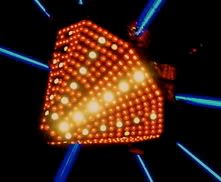
Next time you execute a deadly Counterstrike airstrafe attack using a deft combination of finely honed finger movements, spare a thought for the plastic gadget grasped in the palm of your hand. Yes, the input device now taken for granted in today’s world of rapid-reflex gaming has an interesting history of its own. And it wasn’t always about entertainment.
Take the humble mouse, the modern mainstay of any self-respecting PC gamer. Its first incarnation appeared in 1964, a year of unprecedented innovation for Dr Douglas Engelbart’s Augmentation Research Center at Stanford Research Institute. During the gestation of their revolutionary hypertextual On-Line System, Engelbart and his team believed that the state of computer technology was restricting their ability to develop new and improved technologies, and a fresh way to manipulate information was surely needed. Favouring an acid-induced philosophy of co-evolution, Engelbart redressed the balance with the ‘X-Y Position Indicator for a Display System’. With the connecting cable originally running tail-like from the rear, the device was nicknamed ‘the mouse’, but in using two separate wheels for vertical and horizontal movement, the bulky contraption proved as cumbersome as its former name suggested, and it was later superseded by Xerox PARC’s aptly titled ‘ball mouse’. Replacing the wheels with rollers that contacted against the sides of a single ball proved a masterstroke, and the device swept into the consumer market as a must-have add-on for the Xerox Alto home computer.
Eight dead-skin sullied years later, the mouse went ‘optical’ and ditched the ball, instead adopting state-of-the-art motion-detection thanks to Steve Kirsch of Mouse Systems Corporation. Early optical models employed an x-y coordinate system embedded in the mouse pad, but as computing power grew cheaper soon image-processing chips were embedded into the mouse itself, to eventually herald the modern-day spate of so-called ‘laser mice’. And so the digital rodent was liberated.
Suffering an ungainly protrusion into the real world, the joystick’s future, by comparison, appeared gloomy. The first electrical joystick was invented around 1945 in Germany and was developed for targeting airborne glide bombs against Allied ships, and by a series of, frankly, paradoxical events, eventually fought itself into the home with the release of the Atari 2600 entertainment system. But if the phallic totem thought it had won the peace and comfort of domesticity it was sorely wrong. While the less-than-joy-stick proved its mettle within the scorching life-or-death intensity of a World War II cockpit, it failed to hold its own against the rigours of Daley Thompson's Decathlon and Summer Games (joystick killers of the world unite!) leaving many a gamer cursing their own masturbatory prowess.
Unexpectedly amidst a mountain of peripheral corpses, the holy grail of callous-inducing frenetics emerged – Nintendo’s comparatively asexual D-pad.

Lapped up by millions of NES gamers, the D-pad ruled the console roost for years to come and inspired a wealth of imitators. But like a phoenix risen from the flames, the fabled joystick enjoyed the last laugh with the dawn of the Nintendo 64 controller and the reintroduction of the additional rotary analogue stick. Gamepads followed suit ever since.
Now, in the face of such a winning combination, who could imagine that a device resembling a 70s TV handset dubiously pronounced ‘weemote’ would become the latest console craze?

2 comments:
why.... YES!!!
Hello all
http://worldofwarcraftsupport.com/ - generic effexor xr
This drug is distributed with pentagon-shaped peach-colored tablets with 25 mg, 37.
[url=http://worldofwarcraftsupport.com/]discount effexor[/url]
The common side effects are the following: headache, insomnia, nausea, sexual dysfunction, dizziness, dry mouth and sweating.
effexor drug
5 mg, 50 mg, 75 mg and 100 mg respectively.
Post a Comment